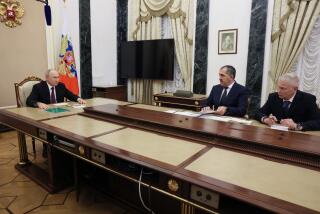Russia Lifts Veil on Elite Shock Troops : Military: Media get to see dreaded Dzerzhinsky Division put on a demonstration at its once-secret base.
- Share via
BALASHIKHA, Russia — They were once the toughest, deadliest, scariest troops to police the Soviet Empire.
Named after Felix Dzerzhinsky, founder of the Bolshevik secret police, the Dzerzhinsky Division liquidated czarist sympathizers, worked out the formula for the Molotov cocktail and trained snipers to torment Hitler’s armies.
In the 1980s, the KGB unit did the Kremlin’s bidding in such hot spots as Afghanistan, Azerbaijan and Nagorno-Karabakh. Last October, when hard-liners seized the Russian Parliament building, Boris N. Yeltsin called in the Dzerzhinsky Division to storm the White House and save his presidency.
On Thursday, the gates of the elite division’s base swung open to journalists, and even foreign reporters were invited in for what commanders said was the first-ever tour of this military holy site about 15 miles east of Moscow.
In a bizarre marriage of Russian military propaganda and Western-style public relations, the once-terrifying special forces now seemed eager to show themselves to the media as a tough but politically correct unit of crime-fighters trained to battle terrorists, drug traffickers, hijackers and organized criminals. With convincing displays of smoke bombs and machine-gun fire, young commandos demonstrated their crime-busting prowess.
First came a display of bulletproof vests, helmets, rifles, pistols, grenade-launchers, stun bombs and tear gas canisters.
Then, as the television cameras rolled, sharpshooters in camouflage burst into a firing range. They pumped bullets straight into their target, a wooden terrorist who appeared to be commandeering a car, holding a gun to the driver’s head. The shooters left holes in the terrorist, but the hostage escaped unscathed.
Beefy recruits showed how to intercept and liberate a “hijacked” bus by posing as road repair workers.
As if to demonstrate Russia’s need for a squad of “untouchables” to deal with its skyrocketing crime, while the mock hijackings were being staged outside Moscow, a very real hijacking of schoolchildren had begun in southern Russia.
Four gunmen seized a bus carrying about 30 people--eight children, their parents and their schoolteachers--near Mineralniye Vody, a resort city whose name means “mineral waters.”
It was the second hijacking involving schoolchildren in five months. Last December, a dozen children from Rostov-on-Don were seized but released in exchange for $10 million and a helicopter. No one was hurt in that incident, and the hijackers were eventually caught, but not all of the ransom money was recovered.
Authorities said Thursday that the new hijackers had also demanded $10 million, as well as 100 vials of morphine, assorted weaponry and a helicopter in which to flee. The terrorists threatened to toss one child’s severed head out of the bus each hour until their demands were met, police said.
By late Thursday, the terrorists had released all the children and one adult in exchange for four submachine guns, a grenade launcher, a night-vision device and some flak jackets, the Itar-Tass news agency reported. About 13 adults were still being held.
Two groups of elite Interior Ministry troops--possibly from the ex-Dzerzhinsky Division--were on their way to the site, the news agency said.
As part of its transformation, the commando unit has dropped the name Dzerzhinsky and is now simply known as the Special Forces Division. But the nickname has stuck, and despite financial hardship it remains one of the most prestigious postings in the Russian military.
More to Read
Sign up for Essential California
The most important California stories and recommendations in your inbox every morning.
You may occasionally receive promotional content from the Los Angeles Times.













